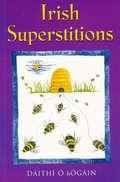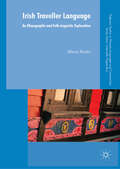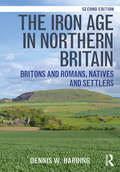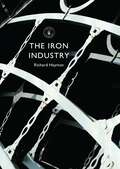- Table View
- List View
Irish Stereotypes in Vaudeville, 1865-1905 (Palgrave Studies in Theatre and Performance History)
by Jennifer MooneyVaudeville is often viewed as the source of some of the crude stereotypes that positioned the Irish immigrant in America as the antithesis of native-born American citizens. Using primary archival material, Mooney argues that the vaudeville stage was an important venue in which an Irish-American identity was constructed, negotiated, and refined.
Irish Superstitions: Irish Spells, Old Wives’ Tales and Folk Beliefs
by Dáithí Ó hÓgáinDáithí Ó hÓgáin, one of Ireland’s leading folklorists, gives a lively and informative account of the widespread folk beliefs of Ireland in Irish Superstitions, this popular guide to Irish superstitions, old wives’ tales and other spooky stuff from the Irish countryside.Irish Superstitions includes a list of good-luck charms, spells, soothsayings and other irrational but charming and creative folk beliefs. There are stories of leprechauns and sprites, ghosts, the evil eye and wise women’s curses. There are also charms and spells to make crops grow, to keep cattle healthy, to ensure safe childbirth, and to fulfil many other longed-for desires. Most of the superstitions are of pagan origin; many were overlaid with popular Christian belief.Irish Superstitions: Table of ContentsForeword — The Mind EngagedMan the Summation of All ThingsThe World Around UsOurselves and the OthersRules and Practices of Life
The Irish tower house: Society, economy and environment, <i>c.</i> 1300–1650 (Social Archaeology and Material Worlds)
by Victoria L. McAlisterThis book examines the social role of castles in late-medieval and early modern Ireland. It uses a multidisciplinary methodology to uncover the lived experience of this historic culture, demonstrating the interconnectedness of society, economics and the environment. Of particular interest is the revelation of how concerned pre-modern people were with participation in the economy and the exploitation of the natural environment for economic gain. Material culture can shed light on how individuals shaped spaces around themselves, and tower houses, thanks to their pervasiveness in medieval and modern landscapes, represent a unique resource. Castles are the definitive building of the European Middle Ages, meaning that this book will be of great interest to scholars of both history and archaeology.
The Irish tower house: Society, economy and environment, <i>c.</i> 1300–1650 (Social Archaeology and Material Worlds)
by Victoria L. McAlisterThis book examines the social role of castles in late-medieval and early modern Ireland. It uses a multidisciplinary methodology to uncover the lived experience of this historic culture, demonstrating the interconnectedness of society, economics and the environment. Of particular interest is the revelation of how concerned pre-modern people were with participation in the economy and the exploitation of the natural environment for economic gain. Material culture can shed light on how individuals shaped spaces around themselves, and tower houses, thanks to their pervasiveness in medieval and modern landscapes, represent a unique resource. Castles are the definitive building of the European Middle Ages, meaning that this book will be of great interest to scholars of both history and archaeology.
Irish Traveller Language: An Ethnographic and Folk-Linguistic Exploration (Palgrave Studies in Minority Languages and Communities)
by Maria RiederThis book explores the Irish Traveller community through an ethnographic and folk linguistic lens. It sheds new light on Irish Traveller language, commonly referred to as Gammon or Cant, an integral part of the community’s cultural heritage that has long been viewed as a form of secret code. The author addresses Travellers’ metalinguistic and ideological reflections on their language use, providing deep insights into the culture and values of community members, and into their perceived social reality in wider society. In doing so, she demonstrates that its interrelationship with other cultural elements means that the language is in a constant flux, and by analysing speakers’ experiences of language in action, provides a dynamic view of language use. The book takes the reader on a journey through oral history, language naming practices, ideologies of languageness and structure, descriptions of language use and contexts, negotiations of the ‘authentic’ Cant, and Cant as ‘identity’. Based on a two-year ethnographic fieldwork project in a Traveller Training Centre in the West of Ireland, this book will appeal to students and scholars of sociolinguistics, language in society, language ideology, folk linguistics, minority communities and languages, and cultural and linguistic anthropology.
The Irish Women’s Movement: From Revolution to Devolution
by Linda ConnollyThis book provides a comprehensive analysis of the emergence, consolidation and development of the Irish women's movement, as a social movement, in the course of the twentieth century. It seek to address several lacunae in Irish studies by illuminating the processes through which the movement and, in particular, networks of constituent organisations, came to fruition as agencies of social change. The central argument advanced is that when viewed historically, the Irish women's movement is characterised by its interconnectedness and continuity: the central tensions, themes and organising strategies of the movement connects diverse organisations and constituencies, over time and space. This book will be essential reading for those interested in Irish studies, sociology, history, women's studies, and politics.
Irishology: Slagging, Junior C Football, Wet Rain and Everything Else We Love about Ireland
by Ronan MooreAh Ireland, it’s a great little country all the same, if only you could put a roof on it. While we may be a nation of messers and begrudgers, we’ll always have a soft spot for our land of sunny spells and scattered showers. Who else but the Irish can perform minor miracles with a prayer to St Anthony? Or truly appreciate the medicinal purposes of Flat 7Up? Not to mention the front room, chipper chips and the ‘bad pint’!From things you’ll only hear and taste in Ireland to tips for surviving any social situation (an Irish wedding anyone?!), Ronan Moore’s witty, irreverent and nostalgic guide will have you laughing your way to a degree in Irishology.Altogether now … ‘Lowwww lie the Fields of Athenryyyy’
Irland: Auf Tour (Auf Tour)
by Armin HüttermannIrland als europäisches Land lässt sich auf dem See- und mittlerweile auch auf dem Luftweg günstig erreichen und fasziniert durch seine einzigartigen Landschaften. Reisende, geographisch Interessierte, aber auch Studierende der Geographie und der Geowissenschaften wünschen sich Informationen zu interessanten und ungewöhnlichen Aspekten sowie Tipps zum besseren Verständnis eines Landes. Mit seinen unterhaltsam präsentierten Länderinformationen ergänzt jedes Buch der Reihe inhaltlich konventionelle Reiseführer, klassische geographische Länderkunden und auch die zahlreichen Länderfakten, die sich im Internet finden. Physiogeographische wie auch humangeographische interessante Highlights zum Natur- und Kulturraum eines Landes erleichtern den Einblick in die Lebenssituationen, die wirtschaftlichen wie auch geschichtlichen Dimensionen und in mögliche oder real existierende Umweltprobleme. Ansprechende Fotos und informative Grafiken wie auch kurze Essays des täglichen Lebens und der Landschaft sind Merkmal dieses Buches.
The Iron Age in Northern Britain: Britons and Romans, Natives and Settlers
by Dennis W. HardingThe Iron Age in Northern Britain examines the archaeological evidence for earlier Iron Age communities from the southern Pennines to the Northern and Western Isles and the impact of Roman expansion on local populations, through to the emergence of historically-recorded communities in the post-Roman period. The text has been comprehensively revised and expanded to include new discoveries and to take account of advanced techniques, with many new and updated illustrations. The volume presents a comprehensive picture of the ‘long Iron Age’, allowing readers to appreciate how perceptions of Iron Age societies have changed significantly in recent years. New material in this second edition also addresses the key issues of social reconstruction, gender, and identity, as well as assessing the impact of developer-funded archaeology on the discipline. Drawing on recent excavation and research and interpreting evidence from key studies across Scotland and northern England, The Iron Age in Northern Britain continues to be an accessible and authoritative study of later prehistory in the region.
The Iron Age in Northern Britain: Britons and Romans, Natives and Settlers
by Dennis W. HardingThe Iron Age in Northern Britain examines the archaeological evidence for earlier Iron Age communities from the southern Pennines to the Northern and Western Isles and the impact of Roman expansion on local populations, through to the emergence of historically-recorded communities in the post-Roman period. The text has been comprehensively revised and expanded to include new discoveries and to take account of advanced techniques, with many new and updated illustrations. The volume presents a comprehensive picture of the ‘long Iron Age’, allowing readers to appreciate how perceptions of Iron Age societies have changed significantly in recent years. New material in this second edition also addresses the key issues of social reconstruction, gender, and identity, as well as assessing the impact of developer-funded archaeology on the discipline. Drawing on recent excavation and research and interpreting evidence from key studies across Scotland and northern England, The Iron Age in Northern Britain continues to be an accessible and authoritative study of later prehistory in the region.
Iron Age Myth and Materiality: An Archaeology of Scandinavia AD 400-1000
by Lotte HedeagerIron Age Myth and Materiality: an Archaeology of Scandinavia AD 400-1000 considers the relationship between myth and materiality in Scandinavia from the beginning of the post-Roman era and the European Migrations up until the coming of Christianity. It pursues an interdisciplinary interpretation of text and material culture and examines how the documentation of an oral past relates to its material embodiment. While the material evidence is from the Iron Age, most Old Norse texts were written down in the thirteenth century or even later. With a time lag of 300 to 900 years from the archaeological evidence, the textual material has until recently been ruled out as a usable source for any study of the pagan past. However, Hedeager argues that this is true regarding any study of a society’s short-term history, but it should not be the crucial requirement for defining the sources relevant for studying long-term structures of the longue durée, or their potential contributions to a theoretical understanding of cultural changes and transformation. In Iron Age Scandinavia we are dealing with persistent and slow-changing structures of worldviews and ideologies over a wavelength of nearly a millennium. Furthermore, iconography can often date the arrival of new mythical themes anchoring written narratives in a much older archaeological context. Old Norse myths are explored with particular attention to one of the central mythical narratives of the Old Norse canon, the mythic cycle of Odin, king of the Norse pantheon. In addition, contemporaneous historical sources from late Antiquity and the early European Middle Age - the narratives of Jordanes, Gregory of Tours, and Paul the Deacon in particular - will be explored. No other study provides such a broad ranging and authoritative study of the relationship of myth to the archaeology of Scandinavia.
Iron Age Myth and Materiality: An Archaeology of Scandinavia AD 400-1000
by Lotte HedeagerIron Age Myth and Materiality: an Archaeology of Scandinavia AD 400-1000 considers the relationship between myth and materiality in Scandinavia from the beginning of the post-Roman era and the European Migrations up until the coming of Christianity. It pursues an interdisciplinary interpretation of text and material culture and examines how the documentation of an oral past relates to its material embodiment. While the material evidence is from the Iron Age, most Old Norse texts were written down in the thirteenth century or even later. With a time lag of 300 to 900 years from the archaeological evidence, the textual material has until recently been ruled out as a usable source for any study of the pagan past. However, Hedeager argues that this is true regarding any study of a society’s short-term history, but it should not be the crucial requirement for defining the sources relevant for studying long-term structures of the longue durée, or their potential contributions to a theoretical understanding of cultural changes and transformation. In Iron Age Scandinavia we are dealing with persistent and slow-changing structures of worldviews and ideologies over a wavelength of nearly a millennium. Furthermore, iconography can often date the arrival of new mythical themes anchoring written narratives in a much older archaeological context. Old Norse myths are explored with particular attention to one of the central mythical narratives of the Old Norse canon, the mythic cycle of Odin, king of the Norse pantheon. In addition, contemporaneous historical sources from late Antiquity and the early European Middle Age - the narratives of Jordanes, Gregory of Tours, and Paul the Deacon in particular - will be explored. No other study provides such a broad ranging and authoritative study of the relationship of myth to the archaeology of Scandinavia.
Iron and Steamship Archaeology: Success and Failure on the SS Xantho (The Springer Series in Underwater Archaeology)
by Michael McCarthyIn the early 1980s the author was asked to investigate the newly discovered wreck of the Xantho, an iron screw steamship active off the Australian coast during the period 1848 to 1872, and to develop a strategy to stop the looting that was occurring at the site. This relatively straightforward assignment turned into a long-term research program for applying maritime archaeology to the conservation of iron-hulled wrecks.
The Iron Cage Revisited: Max Weber in the Neoliberal Era (Classical and Contemporary Social Theory)
by R. Bruce DouglassAt the start of the twentieth century, when Germany, among other nations, was undergoing industrialization, Max Weber famously characterized modern life in words that have often been translated as "iron cage." During the industrial era, that image caught on and was often used by scholars to express concerns about the extent to which the actual character of modern life contradicted its emancipatory promise. But we are living in a different time now, when the conditions under which we live seem to be quite different from the ones that pertained in Weber's day. It is a time when, in some respects at least, life seems to be freer and more conducive to experimentation, which has led some people to conclude that our societies have escaped from Weber's "cage." But is that really true? This book challenges that notion, considering the consequences for our way of life of the triumph of neoliberalism as a political force.
The Iron Cage Revisited: Max Weber in the Neoliberal Era (Classical and Contemporary Social Theory)
by R. Bruce DouglassAt the start of the twentieth century, when Germany, among other nations, was undergoing industrialization, Max Weber famously characterized modern life in words that have often been translated as "iron cage." During the industrial era, that image caught on and was often used by scholars to express concerns about the extent to which the actual character of modern life contradicted its emancipatory promise. But we are living in a different time now, when the conditions under which we live seem to be quite different from the ones that pertained in Weber's day. It is a time when, in some respects at least, life seems to be freer and more conducive to experimentation, which has led some people to conclude that our societies have escaped from Weber's "cage." But is that really true? This book challenges that notion, considering the consequences for our way of life of the triumph of neoliberalism as a political force.
Iron in the Soul: Displacement, Livelihood and Health in Cyprus (Forced Migration #23)
by Peter LoizosIn his vivid, lively account of how Greek Cypriot villagers coped with a thirty-year displacement, Peter Loïzos follows a group of people whom he encountered as prosperous farmers in 1968, yet found as disoriented refugees when revisiting in 1975. By providing a forty year in-depth perspective unusual in the social sciences, this study yields unconventional insights into the deeper meanings of displacement. It focuses on reconstruction of livelihoods, conservation of family, community, social capital, health (both physical and mental), religious and political perceptions. The author argues for a closer collaboration between anthropology and the life sciences, particularly medicine and social epidemiology, but suggests that qualitative life-history data have an important role to play in the understanding of how people cope with collective stress.
The Iron Industry (Shire Library)
by Richard HaymanThe iron industry was the catalyst for the Industrial Revolution, producing a vital source of iron without which none of the great engineering achievements of the Victorian age would have been possible. This book charts the growth of iron making from the Middle Ages, covering the importation of blast-furnace methods in the fifteenth century, the adoption of coke as a fuel in the eighteenth century, and the invention of mass-produced steel in the nineteenth century. The developing techniques of iron making, all explained in a non-technical style, make a story in their own right, but combined with the experiences of the masters and workmen who laboured at the furnaces and forges, this volume offers a truly comprehensive account of one of the most important industries of recent centuries.
The Iron Industry: The History And Archaeology Of The Iron Industry (Shire Library #817)
by Richard HaymanThe iron industry was the catalyst for the Industrial Revolution, producing a vital source of iron without which none of the great engineering achievements of the Victorian age would have been possible. This book charts the growth of iron making from the Middle Ages, covering the importation of blast-furnace methods in the fifteenth century, the adoption of coke as a fuel in the eighteenth century, and the invention of mass-produced steel in the nineteenth century. The developing techniques of iron making, all explained in a non-technical style, make a story in their own right, but combined with the experiences of the masters and workmen who laboured at the furnaces and forges, this volume offers a truly comprehensive account of one of the most important industries of recent centuries.
Iron John: A Book About Men (Los Caballeros Del G Ser.)
by Robert BlyRobert Bly writes that it is clear to men that the images of adult manhood given by popular culture are worn out, that a man can no longer depend on them. Iron John searches for a new vision of what a man is or could be, drawing on psychology, anthropology, mythology, folklore and legend. Robert Bly looks at the importance of the Wild Man (reminiscent of the Wild Woman in Women Who Run With the Wolves), who he compares to a Zen priest, a shaman or a woodman.'This book needs to be read, I believe, not as a dry work of scholarship to be judged coolly by the mind, but as the work of a poet struggling to convey an emotional experience and lead us to what he has found within himself' Guardian'Eclectic and unclassifiable. Iron John is a work whose mentors are the prophetic poets and crazies, William Blake and Walt Whitman' Sydney Morning Herald'Important.timely.and powerful' New York Times
The Iron Men: The Workers Who Created the New Iron Age
by Anthony BurtonThe eighteenth century saw the second Iron Age. Practically everything was made of iron: the machines of the Industrial Revolution; bridges and the ships that went under them; the trains running on their rails; and the frames of the first skyscrapers. But progress was bought at a price and the working classes paid it. The knife grinders of Sheffield were lucky to reach their 30th birthday before their ruined lungs gave up, women chain makers were described as ‘The White Slaves of England’ and, in a time before health and safety regulations, each advance in technology risked a new kind of deadly accident. Tracking both the brilliant innovation of the period and the hardship and struggle that powered it, this is the story of how iron changed the world.
Iron, Steam & Money: The Making of the Industrial Revolution
by Roger OsborneIn late eighteenth-century Britain a handful of men brought about the greatest transformation in human history. Inventors, industrialists and entrepreneurs ushered in the age of powered machinery and the factory, and thereby changed the whole of human society, bringing into being new methods of social and economic organisation, new social classes, and new political forces. The Industrial Revolution also dramatically altered humanity's relation to the natural world and embedded the belief that change, not stasis, is the necessary backdrop for human existence.Iron, Steam and Money tells the thrilling story of those few decades, the moments of inspiration, the rivalries, skulduggery and death threats, and the tireless perseverance of the visionaries who made it all happen. Richard Arkwright, James Watt, Richard Trevithick and Josiah Wedgwood are among the giants whose achievements and tragedies fill these pages. In this authoritative study Roger Osborne also shows how and why the revolution happened, revealing pre-industrial Britain as a surprisingly affluent society, with wealth spread widely through the population, and with craft industries in every town, village and front parlour. The combination of disposable income, widespread demand for industrial goods, and a generation of time-served artisans created the unique conditions that propelled humanity into the modern world.The industrial revolution was arguably the most important episode in modern human history; Iron, Steam and Money reminds us of its central role, while showing the extraordinary excitement of those tumultuous decades.
The Ironic Spectator: Solidarity in the Age of Post-Humanitarianism
by Lilie ChouliarakiWINNER of the 2015 ICA Outstanding Book Award This path-breaking book explores how solidarity towards vulnerable others is performed in our media environment. It argues that stories where famine is described through our own experience of dieting or or where solidarity with Africa translates into wearing a cool armband tell us about much more than the cause that they attempt to communicate. They tell us something about the ways in which we imagine the world outside ourselves. By showing historical change in Amnesty International and Oxfam appeals, in the Live Aid and Live 8 concerts, in the advocacy of Audrey Hepburn and Angelina Jolie as well as in earthquake news on the BBC, this far-reaching book shows how solidarity has today come to be not about conviction but choice, not vision but lifestyle, not others but ourselves – turning us into the ironic spectators of other people’s suffering.
The Ironic Spectator: Solidarity in the Age of Post-Humanitarianism
by Lilie ChouliarakiWINNER of the 2015 ICA Outstanding Book Award This path-breaking book explores how solidarity towards vulnerable others is performed in our media environment. It argues that stories where famine is described through our own experience of dieting or or where solidarity with Africa translates into wearing a cool armband tell us about much more than the cause that they attempt to communicate. They tell us something about the ways in which we imagine the world outside ourselves. By showing historical change in Amnesty International and Oxfam appeals, in the Live Aid and Live 8 concerts, in the advocacy of Audrey Hepburn and Angelina Jolie as well as in earthquake news on the BBC, this far-reaching book shows how solidarity has today come to be not about conviction but choice, not vision but lifestyle, not others but ourselves – turning us into the ironic spectators of other people’s suffering.
Ironie in der Alltagssprache: Eine gesprächsanalytische Untersuchung
by Martin HartungDie Untersuchung geht auf der Grundlage von zwanzig Stunden Tonband-Aufnahmen von authentischen Alltagsinteraktionen der Frage nach, was in privater Kommunikation als ironisch gilt, wie und warum ein Sprecher Ironie einsetzt und wie die Zuhörer darauf reagieren. Es zeigt sich, daß ironische Äußerungen kommunikativ als negative Bewertungen wirken, aufgrund ihrer indirekten Ausdrucksweise aber ein beachtliches Wirkungsspektrum entfalten. Dieses wird anhand zahlreicher Belege aus dem Korpus detailliert analysiert und auf soziale Gruppenprozesse der Aushandlung, Bestätigung und Abgrenzung von gemeinsamen Wertmaßstäben bezogen.


















